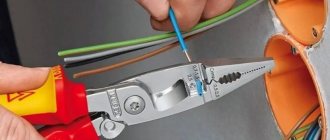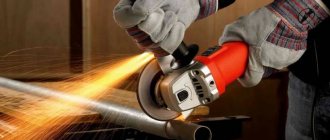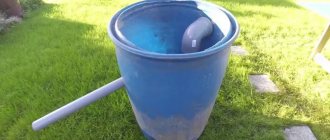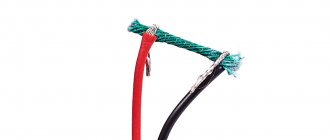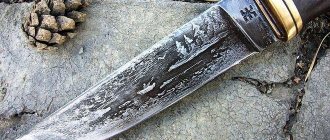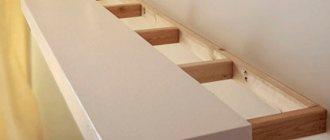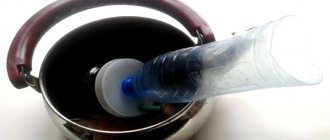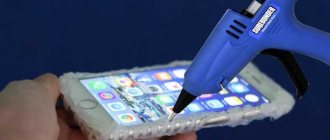Winter fishing is an interesting and exciting activity that requires a sufficient amount of endurance and patience, as well as physical strength.
After all, this is not just fishing, but hard work, especially when you consider how many holes you have to drill in a day in search of fish, while in full equipment. The only thing is that much less gear is needed than in summer. Basically, classic winter gear sets are used for fishing with a jig or spinner. But some avid fishermen, who are constantly searching, modify their gear, which makes fishing more productive. Of particular interest is the option of a self-hooking fishing rod for winter fishing, which is not at all difficult to make yourself.
A self-hooking winter fishing rod is interesting because it allows you not to miss the moment of a fish bite. This factor has a positive effect on successful fishing.
Types of self-cutters for different types of gear
Any gear used, including donkeys, is equipped with devices for automatic hooking.
Most often, these devices are installed on float rods, ordinary hooks and feeders. Structurally, the devices are divided into:
- modernized - floats and hooks, which, due to minor modifications in their design, allow hooking without a fisherman;
- homemade - a device made with one’s own hands and working on the principle of a mousetrap;
- factory - technological mechanisms designed for a specific type of gear.
Depending on the chosen tackle, hookers are:
- for bottom fishing - help to perform automatic hooking when fishing with a standard bottom rod;
- for the feeder - a wide variety of devices designed for installation on gear. Special hooks can also be used, the design features of which allow, when swallowed and pulled up by a fish, to easily insert the sting into the fish’s mouth and hold it there when playing;
- for a fishing rod with a float - devices similar to feeder ones or special floats are used that have a movable washer on their antenna.
An example of a self-cutting device for a donkey
When biting is active, automatic hooking is not needed, because Most of the fisherman’s time will be spent recharging the device, thereby distracting him from the bite.
Description and advantages of the device
The main element of a fishing rod with a self-hooking hook is a special spring that works on the principle of a mousetrap. When the line is tensioned, the device instantly triggers and performs a precise hook. This is very convenient when fishing with several gears, when it is physically difficult to catch the prey manually, or when the fish bites weakly, because the minimum tension of the equipment causes a quick jerk of the spring, as a result of which the fish is hooked. Currently, a similar technique is used to catch both small and larger representatives of ichthyofauna.
The mechanism itself is compact in size, so when placed near the handle of the fishing rod, it does not cause discomfort to the fisherman and does not interfere with the fishing process. In addition, with its help you can avoid frequent loss of catch due to unsuccessful hookings or incorrect actions when fishing.
If you understand the basic intricacies of the self-hooking device, then in the future it will be possible to make it a valuable assistant for fishing, which will allow you to save your energy for other important actions and increase the chances of effective fishing.
It is important to note that making a self-hooking fishing rod with your own hands (drawings, instructions and diagrams are freely available) is quite simple. First you need to understand the design features of the product.
So it consists of:
- Handles.
- Rubber bands.
- Recesses for the trigger mechanism.
- Steel spring.
- Nylon threads with loops for fastening them.
- Loop for fixing the trigger.
- Six.
- Trigger.
- Telescopic nod.
- Nod bases.
- Fishing lines.
- Inertial braking coil.
- Folding legs.
The design also includes a spring groove and a trigger rod.
By the way, such elements can be present in self-hookers for all gear and donks. But in most cases, they are used to equip ordinary bait, feeder and even float gear.
And although the list of necessary components is quite extensive, each of them plays an important role and is indispensable when creating a device. Individually, all the elements are very simple and are available on the market or even in a home workshop.
Varieties
There are several options for fishing rods with automatic hooking.
- Factory ones. Such fishing rods are produced by manufacturing plants. They are neat and have a standard technological mechanism. They are described in this article, since they are a standard. Popular models: FisherGoMan, LEO Professional Fishing, “King of Fishing”.
- Homemade. Some people prefer to make automatic hook hooks for fishing rods themselves. It will not be difficult for an experienced fisherman to make such a device if he knows the principle of its operation. They are usually made for a specific type of fish.
- Improved gear. The basis of the design here is a factory model or a home-made mechanism, which is improved by replacing some components or installing others.
The automatic cutting mechanism does not differ depending on seasonality. Such fishing rods are suitable for both summer and winter fishing. The principle of their operation is the same, they differ only in appearance.
Other solutions to the problem
There are also options invented by ordinary fishermen. One of them is an automatic float cutter. It goes like this:
- The upper antenna is pulled out of the float.
- You need to put a foam ring on it. The ring size is slightly larger than the antenna.
- Now you need to return the antenna to its place. Attach a bead to the top.
- During the bite, the ring will not allow the float to sink to the bottom, and the fish will be hooked.
An automatic hooker is indispensable if your fishing goes on for a long time and you want to relax, but at the same time not lose your catch.
An example of a homemade self-cutting device for a feeder
https://www.youtube.com/watch{q}v=WHl7YPG7-FA
A very interesting design for a self-cutter for a spinning rod was invented by Sergei Fedorov. Its device has a good appearance and is well thought out from a technical point of view. By the way, this mechanism can also be used as a regular stand on the shore, without using the additional automatic hooking function.
Electronics for DIYers in
The numbers on the diagram indicate:
- Rod (spinning).
- The front bracket of the rocker arm on which the fishing rod is attached.
- Rocker body.
- Securing the axis of the rocker to the stand around which it rotates.
- Rear rocker bracket. The upper part of the spring is attached to it.
- Spring.
- Main stand of the undercutter. It needs to be made from stainless steel angle.
- Holes on the main post. They are needed to strengthen or weaken the tensile force of the spring.
- Shock-absorbing rubber. It is necessary to soften the action of the spring.
- Attaching the rubber to the bracket body.
- Bracket axis.
- Trigger. It is made of steel and must have a certain bend in the upper part to allow it to slide off the axis of the bracket when cutting (this must be selected experimentally).
- Attaching the bracket axle to the rocker body.
- Main line with accessories.
- Coil.
The mechanism is adjusted after fixing the main stand in the ground. The sensitivity of the trigger depends on the upper bend of the trigger.
For a simple and cheap design you will need the following materials and tools:
- stationery erasers 2 pcs;
- paperclip 1 pc;
- pliers.
Stages of manufacturing a self-cutter for a feeder from a paper clip.
- The elastic bands are threaded into each other, connecting together.
- One end of the elastic band is attached to the leg of the reel.
- The metal clip is straightened into a straight wire.
- Hooks are formed along the edges of the resulting wire.
- After casting the bait, one end of the device is fixed to the first ring of the tackle.
- Using a fishing line, the self-cutter is cocked, and the free end with the hook is fixed.
- After setting, you need to check the operation of the device once, then cock it back to its working position.
A more advanced type of automatic hooker is similar to the principle of operation of a mousetrap. To make it you will need:
- grinder and drill with attachments;
- metal rods with a diameter of 3 mm and 1.2 mm;
- duralumin corner 25*25 mm;
- door spring;
- bolts and nuts.
To make a self-cutting device for a feeder, you will need a steering wheel with attachments
Stages of making a homemade undercutter.
- A stand is made from a duralumin or aluminum corner to secure the device on the shore. Length approximately 7-10 cm.
- A balancer with two brackets is made from a 3 mm steel rod, the back of which is made in the form of the letter “D”, the front in the form of “C”. Both brackets should be located perpendicular to the axis of the balancer and opposite each other.
- A loop is made in the middle of the balancer to secure it to the stand. When bending the front bracket, a loop is made to attach the mechanism trigger.
- The trigger with a loop, ring and hook is made of 1.2 mm steel rod. The moving part of the mechanism is made from it. It consists of two straight cuts connected to each other. The first is connected to the front bracket along with the trigger, the second is bent a little and passed into the ring in the middle of the trigger.
- The moving elements are fixed 6-7 cm below the top of the rack when it is in the working position. A small wire hook is installed on the back.
- Using a 6 mm bolt and the same nut, the trigger is attached to the front clamp loop.
- Up to 5 holes are drilled in the rack, at a distance of approximately 25-30 cm from the top.
- The balancer is hinged to the post using an 8mm bolt and matching nut.
- The spring is secured by the hook of the handle to the holes on the stand and to the rear bracket.
After assembling the device, the process of installing the device begins.
- The balancer bends, forming a right angle between its base and the upper side of the rack.
- The connection of the moving sections of the trigger mechanism is attached to a hook on the back side of the rack.
- The free end of one moving part is passed into the trigger ring in the middle.
- The fishing rod is secured in the clamps of the balancer, and the excess fishing line is unwound.
- The line is pulled back and hooked onto the trigger hook.
- Pulling up, the fishing line lifts the trigger hook, the end of one moving part pops out of the trigger hole, releasing the rocker arm with the spring. The latter jerks upward, performing a sweep.
The mechanism is adjusted after fixing the main stand in the ground. The sensitivity of the trigger depends on the upper bend of the trigger.
Design and principle of operation of the automatic undercutter
A winter fishing rod with a self-hook consists of the following elements:
- lever;
- rubber;
- groove for the trigger rod;
- loop for securing nylon thread;
- nylon thread;
- spring, preferably made of steel;
- loop for mounting the trigger rod and inserting monofilament from the spool to the nod;
- six;
- trigger;
- a nod that can extend;
- nod base;
- monofilament;
- folding legs for fixing the rod in manual mode;
- inertial damper with brake;
- spring groove;
- trigger rod.
During the bite, the monofilament connected to the guard moves forward. After this, the guard is shifted from the stop under the action of a spring, and then instantly thrown back, pulling the monofilament donkey along with it.
When the fish takes the bait, the spring will stretch to a certain size, providing slight resistance to the movement of the catch. Then there is a sharp stop and the hook is securely hooked into the mouth of the fish, the so-called hooking. Naturally, it is almost impossible for the fish to get into the hook, but it is best not to pull when fishing. Practice shows that especially in winter, this device pays off more than ever.
Even in the most severe frosts, a loop with a monofilament autocutter will not freeze up and will retain its elasticity characteristics at normal levels. You will never be left without a big catch! This has already been verified!
Instructions for fishing with an autohook
To understand what a feeder self-cutter is, you need to understand its structure, operating principle and types. The device is auxiliary when fishing with a feeder and does not represent a full-fledged self-hooking tackle.
Self-cutting device for feeder
A classic automatic feeder cutter - homemade or factory-made - consists of the following main elements:
- Support post - serves to fasten the self-cutting device in the soil of the bank;
- Rocker arms - designed to fix the rod handle;
- Springs - when there is a bite and the trigger mechanism is activated, under the influence of elastic force, it gives the feeder itself a jerky upward movement - a hook;
- Trigger mechanism - designed to trigger the spring-loaded rocker arm at a certain tension of the fishing line by the fish.
Such an automatic hook hook for fishing, when properly configured, virtually eliminates idle triggering and ensures the maximum number of productive hooks. In addition to fishing stores, you can purchase it on various Internet portals.
In addition to store-bought self-cutters for feeders, homemade ones have recently become widespread. They are in no way inferior to, and sometimes even superior to, their factory counterparts. There are plenty of videos and drawings on the Internet that make the process of creating a device easier.
Self-cutting fishing rod: where to buy
Self-cutting fishing rod for winter fishing Novy Oskol
Currently this is not a problem. It is enough to visit a well-known fishing store or use an online store. In any case, it is possible to obtain comprehensive information about the availability of various design solutions. Financial capabilities, as well as personal preferences, play an important role. And, nevertheless, this simple device will very quickly pay for itself, no matter how much it costs.
Purpose and technical characteristics
As you know, the most active and interesting part of fishing begins at the moment when the fish bites.
Some fish species are careful, others not so much, and begin to taste the bait. It is at this moment that you need to make an effective hook
Such hooking is quite possible if you fish with one fishing rod, and even better - if you constantly hold it in your hands.
Important! Always, on every fishing trip, you need to take into account the physiological characteristics of the type of fish you are catching. The strength and speed with which it needs to be cut depends on this
https://www.youtube.com/video/TTNyrwu1vZ8
If you are fishing with several gear, which is often the case in feeder fishing, you simply may not have enough time to react to the bite, run to the right rod and hook.
These devices, during a bite, provide the necessary jerk of the equipment in automatic mode. Quite often, experienced fishermen, based on a independently developed design, make a self-hook for a spinning rod with their own hands.
A self-hook designed for spinning also exists, although many anglers doubt its necessity, because spinning fishing assumes that the form is in the hands of the angler all the time. It is rational to use an automatic hook for spinning only when fishing by trolling or if the spinning rod is adapted for feeder gear.
An automatic fishing rod with an automatic hooker is useful for long-term fishing, when the angler cannot constantly be near it, as well as in the case when fishing is carried out with several (sometimes 4-5) rods.
Depending on their design and manufacturer, these devices are divided into the following types:
- Improved gear. This type includes floats and hooks, which, by making certain changes to their design, allow you to hook fish without the participation of a fisherman.
Various homemade designs. As a rule, a do-it-yourself automatic fish hooker and its operation scheme are based on the same principle of operation as a regular mousetrap. The main driving force in them is either dense rubber or a tensioned spring of the required power. Industrial devices. This type includes technologically advanced mechanisms that were originally designed for a particular gear.
Auto hooking is often used when fishing with more than one fishing rod, which is far from uncommon for feeder fishing. It is also advisable to get a self-hooking hook if bites are rare or you have to fish at night. When fishing, you need to take into account the breed and physiological characteristics of the fish you want to catch. The strength and speed required for hooking depends on this. The purpose of self-cutters is as follows:
- perform the hook in a timely manner and with the necessary force without the participation of the fisherman;
- provide a jerk of the equipment in automatic mode;
- perform a hook if the fisherman falls asleep while fishing at night.
Devices for automatic hooking quickly respond even to a weak bite during feeder fishing and provide the necessary line tension. This increases the chances of returning home with a rich catch, allows you to do something else in parallel with fishing, and also makes it possible to catch fish without having to be present in person.
Technically, the self-cutter looks like this:
- support stand - necessary for installing the device on the shore;
- rocker - to secure the fishing rod handle;
- spring - creates an upward jerk of the feeder (hook) when the fish swallows the hook;
- trigger (trigger) - helps to trigger the rocker when the fishing line is pulled by the fish.
As you know, the most active and interesting part of fishing begins at the moment when the fish bites.
Some fish species are careful, others not so much, and begin to taste the bait. It is at this moment that you need to make an effective hook
Such hooking is quite possible if you fish with one fishing rod, and even better - if you constantly hold it in your hands.
Important! Always, on every fishing trip, you need to take into account the physiological characteristics of the type of fish you are catching. The strength and speed with which it needs to be cut depends on this
If you are fishing with several gear, which is often the case in feeder fishing, you simply may not have enough time to react to the bite, run to the right rod and hook.
Advantages of homemade products
A hooker is necessary for all those who fish with more than 2 rods and when fishing prefer not to sit in front of a rod pod or stands waiting for a bite. For example, carp anglers have to wait several hours for a bite, and every fish caught is very important.
Chinese manufacturers of fishing equipment offer industrially manufactured self-hooks, but they are not in great demand and are of much worse quality than homemade devices. In addition, when making a hook hook with your own hands, the fisherman customizes the design in accordance with his needs and makes almost unique things.
Making homemade self-cutters for donks does not require significant financial expenses, because available and inexpensive materials are used. This is another important argument in favor of making a device for hooking fish with your own hands and not having problems while fishing.
Even in strong winds or rain, a high-quality auto hooker remains in working order until the fish bites. While waiting for a bite, the angler can do other things, because the condition of his bottoms is closely monitored by self-hookers.
All types of feeder installations:
Paternoster (Gardner loop)
The Paternoster or Gardner Loop rig can serve as an excellent tool when fishing in any type of body of water (both on a river and in still water).
The Gardner loop is a main fishing line with bait, from which a leash with a weight feeder extends. As a rule, the main line should be of a larger diameter (0.2 - 0.3 mm), and the secondary line should not be more than 0.2 mm.
The main line is folded flush with the thin line and a knot is tied at a distance of 40 cm from the end. The stronger the knot, the better; thin fishing line should not slide along the main fishing line. The Figure Eight knot is ideal.
We cut off one end of the secondary fishing line and shorten the second to 20 cm - we get a leash onto which we knit a swivel with a clasp at a distance of 10 cm. The feeder is attached to the clasp. At the end of the main fishing line we tie a leash using the “loop to loop” method. See how to knit this knot.
In the video you can watch the entire process of manufacturing feeder equipment from Alexey Fadeev.
Symmetrical loop
An installation called “Symmetrical loop” is usually made from fluorocarbon fishing line (diameter from 0.28 - 0.31 mm).
The peculiarity of this installation is that it has a self-cutting function, which is not available in a number of alternative feeder equipment.
The manufacturing process is reflected in the video and diagram.
An important aspect is the nuance that the length of the twisted fishing line together with the loop should be longer than the total height of the hanging feeder on the anti-twist.
Installation diagram “Symmetrical loop”
Asymmetrical loop
The fishing line in this type of installation is recommended with increased sensitivity, so professionals give their preference to fluorocarbon fishing line.
First of all, it is practically invisible, and is also a very durable and poorly deformable material, which affects the sensitivity of the bite.
Installation “Asymmetrical loop” is a modification of equipment with a symmetrical loop with the only difference being that the section of the fishing line on which the swivel with the feeder is located is 2-3 cm longer.
Installation with anti-twist tube (Combine)
Installation diagram with anti-twist tube
Of course, the main feature of this equipment is its ability to prevent tangling and twisting of the fishing line.
Although this type of feeder installation does not have a self-hooking effect, an experienced angler can always achieve greater results with just such a result, because it scares the fish less - it practically does not feel resistance when biting.
Quite simple installation - check out the manufacture of this type of equipment, which can be knitted using either monofilament or braided line.
Inline
0.25-0.35 monofilament
The “Inline” installation is very similar to the asymmetrical loop equipment with only one feature: in the inline you can adjust the free stroke length of the feeder
In this case, there is also a section of twisted fishing line near the terminal loop for the leash with bait. It creates a rigid shape that prevents the leash from getting tangled with the fishing line of the rig. The length of this twisted section is approximately 15 cm, which is fixed with a regular figure eight knot.
Helicopter and two knots
Using this installation you can fish both from the bottom and in slightly higher layers of water. Fans of feeder fishing often choose this equipment for catching roach, bream and silver bream.
This feeder equipment is interesting because it is very, very sensitive to fish bite. Works well in fishing conditions with an active bite.
The manufacturing scheme is quite simple.
Tooling Method (Flat Method)
Flat is, first of all, a form of innovative feeder, which has a fairly simple method of attaching the mounting line, as well as such a feature as the ability to distribute the feed itself using tiny air bubbles, which are stored in the feeder while it is charging.
You can see how the Flat Method behaves in water.
Asymmetrical loop
This feeder equipment was originally invented so that the leash would not get overwhelmed when casting. In principle, this is what happened, but the knitting method added its own disadvantages.
How to knit
This installation should always be knitted on a separate piece of fishing line. First you need to measure out at least 1.5 meters of fishing line and fold it in half:
Now we knit a loop for the leash
After this, we take the fishing line in two hands and begin to roll it between our fingers so that the fishing line begins to curl:
You need to twist the length so that the twist is 2 times longer than the feeder, not taking into account the length of the carabiner.
Now you can tie a knot.
Next, we put a carabiner (or a feeder with a swivel) on one of the ends of the fishing line (any) and move the carabiner so that the outlet points to the side:
You need to withdraw very little, literally 1 maximum 2 centimeters. Otherwise, when removing the equipment, the rigidity of the fishing line will not be enough, and everything will get tangled. When removing an empty rig from the water, the lead release acts like a helicopter and spins the entire rig.
Next, having fixed our bend with the fingers of our left hand, we pass both fishing lines between the fingers of our right hand, and knit a simple knot in this place, threading the fishing line into the loop 2-3 times (this should be done with all knots):
The length of the loop should not exceed 8 centimeters, otherwise the loop will twist.
After this, we cut off one of the ends, and on the remaining piece of fishing line we knit a loop for attaching to the main fishing line, and the installation is ready.
This equipment must be attached to the main line through a swivel and be no more than 50cm long.
Characteristics
- Fishing efficiency: current/still water 100%/60% (bites are clearly visible in the current, often gets confused in still water)
- Risk of overlap: 20% (Out of 10 casts, 2 get tangled)
- Self-hooking: 80% (virtually no need to hook)
- Ease of installation: 0% (Lots of knitting time)
- For bottom fish: 80% (2 fish out of 10 will not be bottom fish, they usually bite when diving)
An asymmetrical loop is quite effective, but only when connected correctly. Often things don’t work out the way you want, and efficiency drops to zero.
Now let’s imagine the behavior of installation in water:
Everything seems to be fine, but when removed from the water, the leash tries to twist the loop, working like a propeller, so you need to use swivels.
Advantages and disadvantages of self-hooking fishing rods
Today there are already some developments in the use of self-hooking fishing rods. It can be noted that such devices have certain advantages and disadvantages.
Advantages of self-hooking fishing rods:
- pronounced signs of universality. The device can be used in any open reservoir for a variety of fish species;
- if the spinning rod has expired for its special purpose, then a self-cutting device can be installed on it;
- There is no need for constant attention to the bite alarm. The most important moment for the fisherman is carried out by the fishing rod itself;
- It is quite possible to manufacture the device yourself;
- convenience associated with transportation. Compact dimensions with low weight allow you to put the fishing rod in a backpack;
- Such devices can be used even by novice fishermen with no sufficient fishing experience.
Disadvantages of self-hooking fishing rods:
- The trigger force setting is the same for all fish belonging to different categories. When adjusted in relation to medium-sized fish, it also reacts to small specimens. If the settings are too fine, the device may even react to waves or wind;
- When released by the manufacturer, factory settings are made. It will be very difficult for the fisherman himself to change them. It is simply impossible to do this on the reservoir itself;
- This fishing rod is only suitable for fish with strong lips. If, for example, the hunt takes place for bream, then it is very easy for it to tear its lips. The fish will come off the hook;
- With the use of such a fishing rod, fishing is somewhat delayed. Meanwhile, there are categories of fish that should be caught immediately after hooking. If you are late with this matter, she can take the tackle to a place where there is a large number of snags. In the case of carp, when it gets hooked, it begins active movements along the shore. At the same time, he can easily confuse all other donks.
Simple and inexpensive design
The procedure for using and making a homemade undercutter for a feeder: the rubber bands are connected into one by threading into each other and fixed at one end by the leg of the reel;
We invite you to familiarize yourself with the subtleties of building a shed from OSB boards
the paperclip is straightened into a straight wire, using pliers, hook-shaped bends are formed along its edges;
Paper clips are inexpensive, so it is possible to practice making a high-quality device without being upset about the breakage of one or two pieces.
The sensitivity of automatic hooking can be adjusted experimentally using the fictitious bite method.
Using the main fishing line, the self-cutter is cocked, and the free wire hook of the self-cutter is fixed.
After cocking the cutting mechanism, you need to check its functionality once, then put it back into automatic mode.
Features and rules for using a self-cutter
- rod weight and length;
- the approximate distance to which the bait is planned to be cast;
- current strength and boat speed;
- characteristics of the fish, its size, weight, type of bite.
Compliance with these rules will significantly reduce the number of empty bites and increase the catch.
Auto hooks easily cope with any fish, regardless of whether it is small or a large predator. The fisherman only needs to adjust the device for a specific species and wait for the catch. Monitor the tension force of the self-cutter. Too strong will not allow the fish to remove it from the stopper, or the hook will simply tear its mouth open and it will leave. A weak tension will have the desired effect on the fish.
Example of a self-cutting device for a feeder
The operating principle of the feeder landing net is very simple:
- a fishing rod with bait is cast at the required distance to a certain place;
- the balancer is installed perpendicular to the stand and is captured by the trigger;
- the fishing rod is inserted into the clamps on the balancer, the weakened fishing line is wound back;
- the fishing line is wound behind the trigger of the mechanism;
- when biting, the fishing line pulls the lever, releasing the balancer. The latter, as a result of the tension force of the spring, jerks upward, producing a hook.
For a simple and cheap design you will need the following materials and tools:
- stationery erasers 2 pcs;
- paperclip 1 pc;
- pliers.
Stages of manufacturing a self-cutter for a feeder from a paper clip.
- The elastic bands are threaded into each other, connecting together.
- One end of the elastic band is attached to the leg of the reel.
- The metal clip is straightened into a straight wire.
- Hooks are formed along the edges of the resulting wire.
- After casting the bait, one end of the device is fixed to the first ring of the tackle.
- Using a fishing line, the self-cutter is cocked, and the free end with the hook is fixed.
- After setting, you need to check the operation of the device once, then cock it back to its working position.
A more advanced type of automatic hooker is similar to the principle of operation of a mousetrap. To make it you will need:
- grinder and drill with attachments;
- metal rods with a diameter of 3 mm and 1.2 mm;
- duralumin corner 25*25 mm;
- door spring;
- bolts and nuts.
To make a self-cutting device for a feeder, you will need a steering wheel with attachments
Stages of making a homemade undercutter.
- A stand is made from a duralumin or aluminum corner to secure the device on the shore. Length approximately 7-10 cm.
- A balancer with two brackets is made from a 3 mm steel rod, the back of which is made in the form of the letter “D”, the front in the form of “C”. Both brackets should be located perpendicular to the axis of the balancer and opposite each other.
- A loop is made in the middle of the balancer to secure it to the stand. When bending the front bracket, a loop is made to attach the mechanism trigger.
- The trigger with a loop, ring and hook is made of 1.2 mm steel rod. The moving part of the mechanism is made from it. It consists of two straight cuts connected to each other. The first is connected to the front bracket along with the trigger, the second is bent a little and passed into the ring in the middle of the trigger.
- The moving elements are fixed 6-7 cm below the top of the rack when it is in the working position. A small wire hook is installed on the back.
- Using a 6 mm bolt and the same nut, the trigger is attached to the front clamp loop.
- Up to 5 holes are drilled in the rack, at a distance of approximately 25-30 cm from the top.
- The balancer is hinged to the post using an 8mm bolt and matching nut.
- The spring is secured by the hook of the handle to the holes on the stand and to the rear bracket.
After assembling the device, the process of installing the device begins.
- The balancer bends, forming a right angle between its base and the upper side of the rack.
- The connection of the moving sections of the trigger mechanism is attached to a hook on the back side of the rack.
- The free end of one moving part is passed into the trigger ring in the middle.
- The fishing rod is secured in the clamps of the balancer, and the excess fishing line is unwound.
- The line is pulled back and hooked onto the trigger hook.
- Pulling up, the fishing line lifts the trigger hook, the end of one moving part pops out of the trigger hole, releasing the rocker arm with the spring. The latter jerks upward, performing a sweep.
If you do everything right, you will have a great fishing device. With a self-cutting feeder, you don’t have to worry that your fishing labor will go unrewarded.
Recommendations
You should not attach a wire hook to the upper rods, as some anglers do. Such structures will prevent you from unhinderedly winding the fishing line onto the reel during the process of landing fish.
Even suspended auto hooks that are properly constructed from reliable and high-quality materials quickly become unusable. This is understandable: even the strongest wire loses its elastic properties and hardness over time. Therefore, when using such fishing devices, it is recommended to take with you at least a couple of spare hooks for possible replacement of a failed hanging structure.
When working with such a device, you need to imagine all the fishing conditions and possible expectations from its outcome:
- rod weight and length;
- approximate planned bait casting range;
- the strength of the current, direction and speed of the boat (if the angler is in it);
- the weight of the expected fish, its size, bite and drag force of the possible catch, as well as the characteristic features of the planned catch.
Before you start working with an automatic hooker, you need to worry about setting up the gear. If a fan of “fish hunting” has a factory design at his disposal, then it is necessary to adjust its sensitivity, following the instructions. If the hooker is homemade, you need to rely on your instincts and experience.
You should approach setting the sensitivity of a self-hooking fishing rod with all responsibility. There is no need to make it too sensitive - it can be triggered by a strong gust of wind and vibrations of waves on the water surface. If you “order” the installation to react only to medium and large fish, then the smaller catch will escape the angler.
Don't rely solely on a self-cutting installation. In many cases, intervention by the fisherman will be required. He will have to adjust his fishing speed.
Visual and detailed instructions for making a simple undercutter can be obtained by watching the following video.
Float based
How to make a nod for a winter fishing rod
People's ingenuity and ingenuity showed themselves in fishing with float tackle. It happens when the bite is activated, and it is physically impossible to catch with two or three fishing rods. The bite occurs, but the fisherman does not have time to hook. For such situations, a self-cutter based on a float was invented. The manufacturing principle is simple:
- a flat foam rubber cylinder is cut out, the size of which is determined experimentally by the diameter of the float;
- the selected piece of foam rubber is placed on the top with free movement along it and fixed with a bead with a cambric.
When bitten, the modified design goes under water. In this case, the cylinder creates significant resistance to immersion, and self-cutting occurs.
The sensitivity of the trigger can be easily adjusted by moving the foam rubber along the alarm antenna.
Attention! When fishing for crucian carp, this modification does not work. The main feature of its bites is the raising of the float, and not sudden drowning, like other fish
For what purposes is it needed?
For the most part, the production of hooks is in demand during the deep winter, when times of depressed biting and low fish activity come. Often, for positive results on fishing, a fairly large amount of testing of currently promising baits and searching for fish sites where they exhibit feeding activity are required. Under such fishing conditions, the fisherman leaves devices at selected hunting points with the ability to independently hook fish, calmly carrying out further exploration of the water area.
By analyzing the results of the rods' performance, and the results of the tackle's performance will undoubtedly be there if a fish approaches, one can draw conclusions about the nature of the fish's diet, its type and the type of bait used. Therefore, it is worth purchasing or making a winter fishing rod of this operating principle because of the possibility of comfortable searching for fish without fear of missing out on a trophy that has come to a pre-selected promising place or to a pre-fed point.
How to do it?
Anyone can make a homemade hook hook for a fishing rod. There are a lot of methods and drawings on the Internet for every taste.
From a paper clip
To begin with, the paper clip is bent and straightened completely along each arc. After this, 3 centimeters are measured from one end. At this point a bend of 120 degrees is made. This side will be hooked to the rod guide. One centimeter below the curved part you need to make a ring that will become a rubber holder. This shape can be made using round teeth. On the other side of the paperclip, a rectangle is formed, one of the sides of which is 2 centimeters. The fishing line will be threaded into this rectangle. Then the paperclip must be bent at a right angle half a centimeter below the resulting figure. Using the “loop-to-loop” method, an elastic band is threaded into the previously bent ring.
This design can be used as a self-hook, but before that you need to install it on the fishing rod: the elastic band is attached to the reel, and the curved end of the wire product is fixed to the first ring of the bottom fishing rod.
When the prey starts to bite, the fishing line will pull the trigger with the wire. The curved end of the latter will jump off the rod ring. In the process of contracting the rubber, which is followed by the wire structure, there will be a sharp tension in the fishing line in the direction other than the vector of the fish’s movement.
The sensitivity of this design can be adjusted while fishing. To adjust, the end of the wire attached to the rod ring must be bent at the optimal angle. Imitating a fish bite will clearly show the fisherman how quickly the curved end will jump off the rod ring, and how much force will be applied to this.
Such a self-cutting device requires sufficient rigidity from the wire to maintain its shape for a long time.
If you don’t have a large paper clip, you can find material that matches the characteristics in any hardware store or household. The required number of rubber bands, if necessary, can be purchased at your nearest stationery store.
Simple
Hooking a fish involves changing the position of the rod during the bite. This kind of work can be done by a regular wire undercutter. It is mounted on a rod rack.
This device consists of a wire frame mounted on a stand. After the tackle is cast, the rod is placed on this frame. It has an open rectangular shape (without one side), the end of the form rests on the edge near the empty edge.
Such a device requires a rigid, durable wire that will hold the rod by the tip even in strong gusts of wind. To fix the fishing line in optimal condition, a porous rubber knob is threaded onto the top of the stand. It will firmly hold the line in a calm position, and when it bites, it will quickly release it.
Bottom fishing rods with self-hookers have gained good fame among fishermen. This is facilitated by the wide flexibility of this device for customization. Various modifications can improve the functionality of such a fishing rod.
Stationary
Another self-cutting device made by yourself. It differs from the previous ones in that it is not attached to the fishing rod, but is an improvised platform for the fishing rod itself. For the durability of the planned product, steel wire is used. It can remain rigid for quite a long time. This wire is cut at 50 centimeters, its ends are bent at right angles. As a result, the wire should have improvised “antennae” 5 cm long, each of which looks in opposite directions. One of the “antennae” curves in the shape of a lambda. Then take another piece of wire equal to 30 cm.
